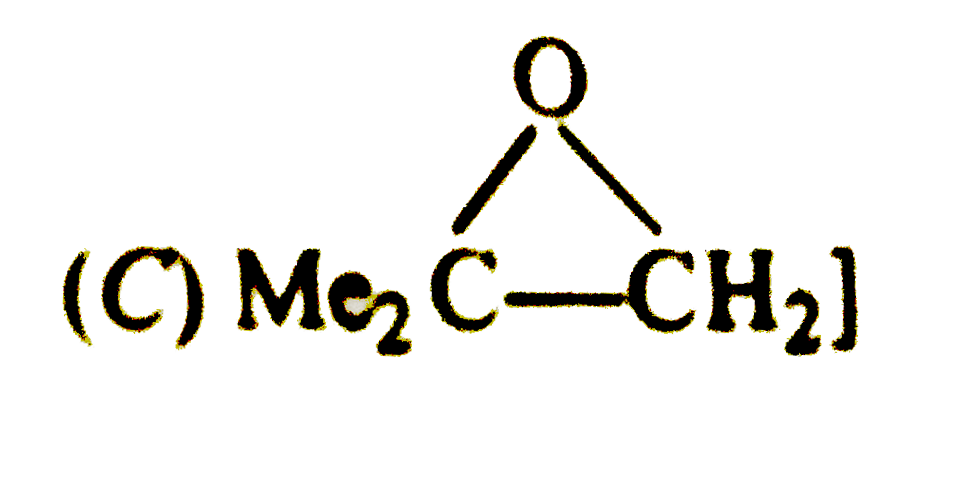Complete the missing links
CH3CHBrCH3alc. KOH−−−−→XHBr, Peroxiden−−−−−−−−→YCH3Ona−−−−→Z
XYZCH3CH=CH2CH3CH(Br)CH2BrCH3CH(OH)CH3
XYZCH3CH=CH2CH3CH2CH2BrCH3CH2OCH2CH3
XYZCH3CH=CH2CH3CH(Br)CH3CH3CH2OCH2CH3
XYZCH3CH=CH2CH3CH2CH2BrCH3CH2CH2OCH3
The correct Answer is:D
To solve the problem, we need to identify the missing compounds X, Y, and Z in the given reaction sequence starting from CH₃CHBrCH₃. Let's break it down step by step.
Step 1: Identify the reaction with alcoholic KOH
The first transformation involves the compound CH₃CHBrCH₃ reacting with alcoholic KOH. Alcoholic KOH is a strong base that promotes elimination reactions (dehydrohalogenation).
Reaction:
- CH₃CHBrCH₃ + alc. KOH → CH₃CH=CH₂ + HBr
Here, the bromine (Br) is eliminated along with a hydrogen atom (H) from the adjacent carbon, resulting in the formation of an alkene.
Missing Compound X:
- X = CH₃CH=CH₂ (Propene)
Step 2: Reaction with HBr in the presence of peroxide
Next, we take the alkene (X = CH₃CH=CH₂) and react it with HBr in the presence of peroxide. The presence of peroxide leads to an anti-Markovnikov addition of HBr to the alkene.
Reaction:
- CH₃CH=CH₂ + HBr (in presence of peroxide) → CH₃CHBrCH₃
In this case, the bromine (Br) will add to the less substituted carbon atom of the alkene.
Missing Compound Y:
- Y = CH₃CHBrCH₂ (Bromo-propane)
Step 3: Reaction with CH₃O⁻Na⁺
Finally, we react compound Y (CH₃CHBrCH₂) with sodium methoxide (CH₃O⁻Na⁺). This is a nucleophilic substitution reaction where the methoxide ion (CH₃O⁻) will replace the bromine atom.
Reaction:
- CH₃CHBrCH₂ + CH₃O⁻ → CH₃CH₂CH₂OCH₃ + Br⁻
This results in the formation of an ether.
Missing Compound Z:
- Z = CH₃CH₂CH₂OCH₃ (Methyl propyl ether)
Summary of the Missing Compounds
- X = CH₃CH=CH₂ (Propene)
- Y = CH₃CHBrCH₂ (Bromo-propane)
- Z = CH₃CH₂CH₂OCH₃ (Methyl propyl ether)
The first transformation involves the compound CH₃CHBrCH₃ reacting with alcoholic KOH. Alcoholic KOH is a strong base that promotes elimination reactions (dehydrohalogenation).
- CH₃CHBrCH₃ + alc. KOH → CH₃CH=CH₂ + HBr
- X = CH₃CH=CH₂ (Propene)
Next, we take the alkene (X = CH₃CH=CH₂) and react it with HBr in the presence of peroxide. The presence of peroxide leads to an anti-Markovnikov addition of HBr to the alkene.
- CH₃CH=CH₂ + HBr (in presence of peroxide) → CH₃CHBrCH₃
- Y = CH₃CHBrCH₂ (Bromo-propane)
Finally, we react compound Y (CH₃CHBrCH₂) with sodium methoxide (CH₃O⁻Na⁺). This is a nucleophilic substitution reaction where the methoxide ion (CH₃O⁻) will replace the bromine atom.
- CH₃CHBrCH₂ + CH₃O⁻ → CH₃CH₂CH₂OCH₃ + Br⁻
- Z = CH₃CH₂CH₂OCH₃ (Methyl propyl ether)
- X = CH₃CH=CH₂ (Propene)
- Y = CH₃CHBrCH₂ (Bromo-propane)
- Z = CH₃CH₂CH₂OCH₃ (Methyl propyl ether)
Topper's Solved these Questions
Similar Questions
Knowledge Check
CH3CHCH3∣Bralc.KOH−−−−−→AHBr−−−−→peroxideBCH3ONa−−−−−→C
In the above reaction sequence, the final product is :Adiethyl etherB1-methoxypropaneCisopropyl alcoholDpropylene glycolIdentify the final product Z in the following
sequence of reactions
C2H5I KOH alc. −−−−−−−→XHBr −−−→YCH_(3)ONa −−−−−−−−→ZAC2H5OCH3BCH2=CH2CC2H5OHDC2H5BrIdentify Z CH3COONH4Δ−−→XP2O5−−→YH2O/H+−−−−−→Z
ACH3CH2CONH2BCH3CNC(CH3CO)2ODCH3COOH
complete the missing links in the folloiwng :
(i)C2H5Na−−→[X]C2H5I−−−→Heat[Y]Cl2(hv)−−−−→[Z]
(ii) C2H5ONaC2H5I−−−→[X]Excess of HBr−−−−−−−→(373K)[Y]KOH(alc.)−−−−−−−→[Z]
(iii) CH3CHBrCH3KOH(alc.)−−−−−→[X]HBr−−−−−−→(Preoxde)[Y]CH3ONa−−−−−→[Z]
(v)
View SolutionCH_(3)CN overset(H_(2)O)rarr X overset("diazomethane")rarr Y
X and Y are
View Solution2CH3COCH3dil.NaOH−−−−−→XNH3−−→Y Y is :
View SolutionGiven that
CH3MgBrO2−−→XCH3MgBr−−−−−→YH3O+−−−→Z The compound Z is
View SolutionIdentify Z in the following sequence of reactions -
CH3COONH4Δ−−→XP2O5−−→YH2∅H−−→Z
View Solution

